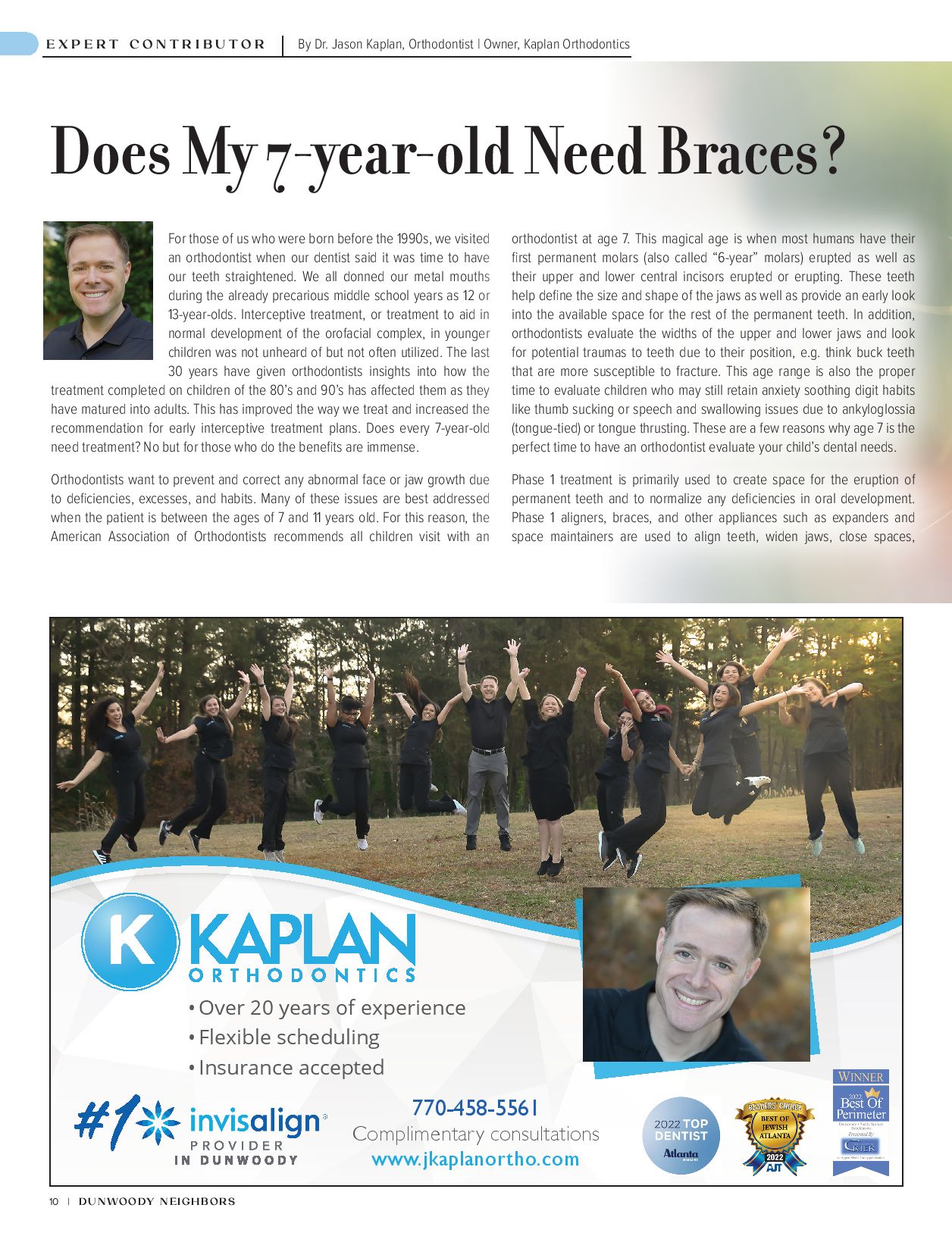
As featured in DUNWOODY NEIGHBORS & NORTH BUCKHEAD NEIGHBORS magazines

Kaplan Orthodontics - Does My 7-year-old Need Braces?
Does My 7-year-old Need Braces?
By Dr. Jason Kaplan, Orthodontist | Owner, Kaplan Orthodontics
For those of us who were born before the 1990s, we visited an orthodontist when our dentist said it was time to have our teeth straightened. We all donned our metal mouths during the already precarious middle school years as 12 or 13-year-olds. Interceptive treatment, or treatment to aid in normal development of the orofacial complex, in younger children was not unheard of but not often utilized. The last 30 years have given orthodontists insights into how the treatment completed on children of the 80’s and 90’s has affected them as they have matured into adults. This has improved the way we treat and increased the recommendation for early interceptive treatment plans. Does every 7-year-old need treatment? No but for those who do the benefits are immense.
Orthodontists want to prevent and correct any abnormal face or jaw growth due to deficiencies, excesses, and habits. Many of these issues are best addressed when the patient is between the ages of 7 and 11 years old. For this reason, the American Association of Orthodontists recommends all children visit with an orthodontist at age 7. This magical age is when most humans have their first permanent molars (also called “6-year” molars) erupted as well as their upper and lower central incisors erupted or erupting. These teeth help define the size and shape of the jaws as well as provide an early look into the available space for the rest of the permanent teeth. In addition, orthodontists evaluate the widths of the upper and lower jaws and look for potential traumas to teeth due to their position, e.g. think buck teeth that are more susceptible to fracture. This age range is also the proper time to evaluate children who may still retain anxiety soothing digit habits like thumb sucking or speech and swallowing issues due to ankyloglossia (tongue-tied) or tongue thrusting. These are a few reasons why age 7 is the perfect time to have an orthodontist evaluate your child’s dental needs.
Phase 1 treatment is primarily used to create space for the eruption of permanent teeth and to normalize any deficiencies in oral development. Phase 1 aligners, braces, and other appliances such as expanders and space maintainers are used to align teeth, widen jaws, close spaces, maintain spaces, help with breathing issues, eliminate habits and correct crossbites. Phase 1 treatment may also help to prevent future dental trauma, jaw surgery, social issues, and the need to remove permanent teeth due to crowding. Sadly, elementary school children are still teased for misaligned teeth and Phase 1 orthodontics can help improve self-confidence. Treatment as a 7-year-old does not mean comprehensive treatment as a teenager will not be needed. If a Phase 1 treatment is completed, it is very likely that a Phase 2 treatment will be completed during middle school. The goal of Phase 1 treatment is to address current alignment or growth issues so they do not develop into more complicated issues needing a more invasive treatment approach when the patient is older.
Does your child need a Phase 1 of orthodontic treatment? Visit with your orthodontic provider to find out exactly what is “growing” on.
To learn more about Kaplan Orthodontics, visit: https://jkaplanortho.com/

about
STACEY RISLEY
Producer and Host | Good Neighbor Podcast North Atlanta
Publisher | North Buckhead Neighbors & Dunwoody Neighbors magazines
Navigation
Copyright © 2023. All rights reserved by Good Neighbor Partners, LLC | Terms and Conditions | Privacy Policy